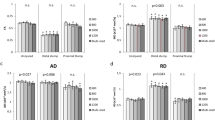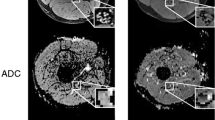Abstract
Piriformis muscle syndrome (PMS) is difficult to diagnose by objective evaluation of sciatic nerve injury. Here we report a case of PMS diagnosed by diffusion tensor imaging (DTI) and tractography of the sciatic nerve, which can assess and visualize the extent of nerve injury. The patient was a 53-year-old man with a 2-year history of continuous pain and numbness in the left leg. His symptoms worsened when sitting. Physical examination, including sensorimotor neurologic tests, the deep tendon reflex test, and the straight leg raise test, revealed no specific findings. The hip flexion adduction and internal rotation test and resisted contraction maneuvers for the piriformis muscle were positive. There were no abnormal findings on magnetic resonance imaging (MRI) of the lumbar spine. The transverse diameter of piriformis muscle was slightly thicker in affected side on MRI of the pelvis. A single DTI sequence was performed during MRI of the pelvis. Fractional anisotropy (FA) and the apparent diffusion coefficient (ADC) of the sciatic nerve were quantified at three levels using the fiber-tracking method. FA values were significantly lower and ADC values were significantly higher distal to the piriformis muscle. We performed endoscopic-assisted resection of the piriformis tendon. Intraoperatively, the motor-evoked potentials in the left gastrocnemius were improved by resection of the piriformis tendon. The patient’s symptoms improved immediately after surgery. There was no significant difference in FA or ADC at any level between the affected side and the unaffected side 3 months postoperatively. MRI-DTI may aid the diagnosis of PMS.







Similar content being viewed by others
References
Bernard TN Jr, Kirkaldy-Willis WH. Recognizing specific characteristics of nonspecific low back pain. Clin Orthop Relat Res. 1987;217:266–80.
Pace JB, Nagle D. The piriformis syndrome. West J Med. 1976;124:435–9.
Fishman LM, Dombi GW, Michaelsen C, et al. Piriformis syndrome: diagnosis, treatment, and outcome: a 10-year study. Arch Phys Med Rehabil. 2002;83:295–301. doi:10.1053/apmr.2002.30622.
Beatty RA. The piriformis muscle syndrome: a simple diagnostic maneuver. Neurosurgery. 1994;34:512–4.
Michel F, Decavel P, Toussirot E, et al. Piriformis muscle syndrome: diagnostic criteria and treatment of a monocentric series of 250 patients. Ann Phys Rehabil Med. 2013;56:371–83. doi:10.1016/j.rehab.2013.04.003.
Pecina HI, Boric I, Smoljanovic T, et al. Surgical evaluation of magnetic resonance imaging findings in piriformis muscle syndrome. Skelet Radiol. 2008;37:1019–23. doi:10.1007/s00256-008-0538-0.
Filler AG, Haynes J, Jordan SE, et al. Sciatica of nondisc origin and piriformis syndrome: diagnosis by magnetic resonance neurography and interventional magnetic resonance imaging with outcome study of resulting treatment. J Neurosurg Spine. 2005;2:99–115. doi:10.3171/spi.2005.2.2.0099.
Basser PJ, Mattiello J, LeBihan D. MR diffusion tensor spectroscopy and imaging. Biophys J. 1994;66:259–67. doi:10.1016/S0006-3495(94)80775-1.
Kabakci N, Gürses B, Firat Z, et al. Diffusion tensor imaging and tractography of median nerve: normative diffusion values. Am J Roentgenol. 2007;189:923–7. doi:10.2214/AJR.07.2423.
Balbi V, Budzik JF, Duhamel A, Bera-Louville A, Le Thuc V, Cotton A. Tractography of lumbar nerve roots: initial results. Eur Radiol. 2011;21:1153–9. doi:10.1007/s00330-010-2049-3.
Wada K, Hashimoto T, Miyagi R, Sakai T, Sairyo K. Diffusion tensor imaging and tractography of the sciatic nerve: assessment of fractional anisotropy and apparent diffusion coefficient values relative to the piriformis muscle, a preliminary study. Skelet Radiol. 2017;46:309–14. doi:10.1007/s00256-016-2557-6.
Miyagi R, Sakai T, Yamabe E, Yoshioka H. Consecutive assessment of FA and ADC values of normal lumbar nerve roots from the junction of the dura mater. BMC Musculoskelet Disord. 2015;16:156. doi:10.1186/s12891-015-0576-4.
Smith J, Hurdle MF, Locketz AJ, Wisniewski SJ. Ultrasound-guided piriformis injection: technique description and verification. Arch Phys Med Rehabil. 2006;87:1664–7. doi:10.1016/j.apmr.2006.08.337.
Eguchi Y, Oikawa Y, Suzuki M, et al. Diffusion tensor imaging of radiculopathy in patients with lumbar disc herniation: preliminary results. Bone Joint J. 2016;98-B:387–94. doi:10.1302/0301-620X.98B3.36036.
Wang H, Ma J, Zhao L, Wang Y, Jia X. Utility of MRI diffusion tensor imaging in carpal tunnel syndrome: a meta-analysis. Med Sci Monit. 2016;22:736–42. doi:10.12659/MSM.895758.
Bernabeu Á, López-Celada S, Alfaro A, Mas JJ, Sánchez-González J. Is diffusion tensor imaging useful in the assessment of the sciatic nerve and its pathologies? Our clinical experience. Br J Radiol. 2016;89:20150728. doi:10.1259/bjr.20150728.
Yamasaki T, Fujiwara H, Oda R, et al. In vivo evaluation of rabbit sciatic nerve regeneration with diffusion tensor imaging (DTI): correlations with histology and behavior. Magn Reson Imaging. 2015;33:95–101. doi:10.1016/j.mri.2014.09.005.
Hernando MF, Cerezal L, Pérez-Carro L, Abascal F, Canga A. Deep gluteal syndrome: anatomy, imaging, and management of sciatic nerve entrapments in the subgluteal space. Skelet Radiol. 2015;44:919–34. doi:10.1007/s00256-015-2124-6.
Author information
Authors and Affiliations
Corresponding author
Ethics declarations
Funding
This case study received no specific grant from any funding agency in the public, commercial, or not-for-profit sectors.
Conflict of interest
The authors declare that they have no conflict of interest.
Ethical approval
All procedures performed in this case involving human participants were in accordance with the ethical standards of the institutional and/or national research committee and with the 1964 Helsinki declaration and its later amendments or comparable ethical standards.
Rights and permissions
About this article
Cite this article
Wada, K., Goto, T., Takasago, T. et al. Piriformis muscle syndrome with assessment of sciatic nerve using diffusion tensor imaging and tractography: a case report. Skeletal Radiol 46, 1399–1404 (2017). https://doi.org/10.1007/s00256-017-2690-x
Received:
Revised:
Accepted:
Published:
Issue Date:
DOI: https://doi.org/10.1007/s00256-017-2690-x




